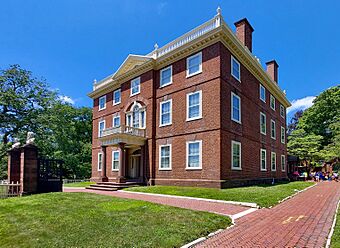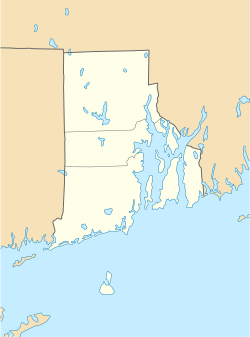John Brown House (Providence, Rhode Island) facts for kids
|
John Brown House
|
|
|
U.S. National Historic Landmark District
Contributing Property |
|

The building in 2024
|
|
| Location | 52 Power St., Providence, Rhode Island |
|---|---|
| Area | 2 acres (0.81 ha) |
| Built | 1786/1788 |
| Architect | Joseph Brown |
| Architectural style | late-Georgian (Federal) |
| Part of | College Hill Historic District (ID70000019) |
| NRHP reference No. | 68000007 |
Quick facts for kids Significant dates |
|
| Added to NRHP | November 24, 1968 |
| Designated NHL | November 24, 1968 |
| Designated NHLDCP | November 10, 1970 |
The John Brown House is a famous old mansion in Providence, Rhode Island. It is located on College Hill, right next to Brown University. This grand house was finished in 1788. It was the very first mansion built in Providence. The house is named after its first owner, John Brown. He was an important person in Rhode Island's history. He was a politician, a businessman, and helped start Brown University. He was also involved in the slave trade.
The John Brown House was named a National Historic Landmark in 1968. This means it is a very important historical place in the United States. An American president, John Quincy Adams, once said it was "the most magnificent and elegant private mansion that I have ever seen on this continent."
Contents
History of the John Brown House
Who Designed and Built It?
The John Brown House was designed by John Brown's brother, Joseph. Joseph was not a professional architect, but he was very talented. He also designed the First Baptist Church in America. The house was built between 1786 and 1788.
Famous Visitors and Features
Many important people visited the house when John Brown lived there. One famous guest was George Washington, the first president of the United States. He reportedly visited for tea. John Brown admired Washington very much. He even designed his house to look a bit like Washington's home, Mount Vernon. One room in the house has a special painting. It shows Washington becoming president. The building also has a carriage house. Inside, there is a special carriage that John Brown owned. People say Washington used this carriage during one of his visits to Providence.
Later Owners and Preservation
In 1901, the house was sold to Marsden J. Perry. He was a rich businessman and banker from Rhode Island. Perry updated the house. He added modern bathrooms and central heating. Later, in 1936, John Nicholas Brown bought the house.
In 1942, the Brown family gave the house to the Rhode Island Historical Society. They wanted to make sure the house was protected and preserved. The society worked to restore the house. They made it look like it did in its original colonial times. Today, the museum has many original pieces of furniture. These items came from the Brown family's estate.
Events at the House
The large lawn of the John Brown House is a popular spot for events. The Rhode Island Historical Society holds its yearly summer concert series here. It's called "Concerts Under the Elms." These concerts feature many local musicians. They play different types of music, like Big Band, Latin Jazz, folk, and oldies. You can also find local food trucks there. They offer meals for everyone to enjoy.
What the House Looks Like
Outside the Mansion
The John Brown House is a three-story building made of brick. It has a special roof called a hipped roof. This roof slopes down on all sides. The very top of the roof is flat. Both the main roof and the flat top have a low fence-like railing called a balustrade. Four chimneys rise from the sides of the house.
The main entrance is in the middle of the house. It sticks out a bit. Above the entrance is a small triangular shape called a pediment. The doorway itself is covered by a porch supported by strong stone columns. Above this porch, there is a large, fancy window with three parts. This is called a Palladian window.
Inside the Mansion
The inside of the house has a classic Georgian design. There is a long hallway in the center. On each side of the hallway, there are two rooms. The main hallway is very grand. It has columns built into the walls. These columns hold up decorative busts, which are sculptures of heads and shoulders.
The staircase is also very impressive. It has two parts and a beautifully twisted railing. You can see detailed wooden decorations in all the main rooms. Eleven of the twelve fireplaces in the house still have their original mantelpieces.
Gallery
-
These busts, representing summer and winter, were reportedly taken from Versailles during the French Revolution
See also
 In Spanish: Casa John Brown (Providence) para niños
In Spanish: Casa John Brown (Providence) para niños








